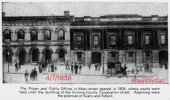The site of Moor Street Station had a very different purpose before the arrival of the railways. The Public Office was built in Moor Street in 1806 as a meeting room and court room. Prisoners were brought from Peck Lane to the court for trial. A holding prison was needed so one was built in 1830. Peck Lane Prison was eventually demolished in 1854. The holding prison was either built at the back of the Public Building or below ground level.
To add a bit of local colour, I'm attaching details of the trial of Alfred Napier Blanchard. It begs the question of why on earth anybody would want to admit to being Jack the Ripper? I just cannot imagine! Viv.

 Engraving by William Emans 1829.
Engraving by William Emans 1829.
To add a bit of local colour, I'm attaching details of the trial of Alfred Napier Blanchard. It begs the question of why on earth anybody would want to admit to being Jack the Ripper? I just cannot imagine! Viv.

















